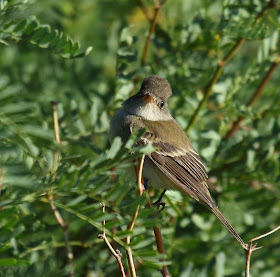The most common small flycatcher present this day was Willow Flycatcher. I estimated there were 7, but there could easily have been more. I found only 2 the next day. One of the notoriously difficult to identify Empidonax flycatchers, this Empid has these ID marks: Short primary projection past the secondaries, eye ring almost lacking, all-yellow under mandible, brownish-olive plumage, white throat. A liquid "whit!" call and an occasional sneezy "fitz-bew!" song, helped confirm. Not all birds sing in migration, many wait until they are on the breeding grounds. So having an aural confirmation of identity is always nice for this look-a-like group.
 |
| Willow Flycatcher. Borrego Springs waste treatment ponds, California. May 26, 2019. |









Thank you for helping identify what I've only known as a songbird up until now. Over the years I've shared my back porch with multiple fledglings, watching in awe as their parents darted in and out with mouths of food,
ReplyDeleteIt's a highlight of the start of summer around here. Again my thanks
That's great, Ruth! I'm glad you have determined you have a flycatcher as a summer nester on your back porch. The dull greenish flycatcher that commonly nests on porches is a phoebe. In the east that's Eastern Phoebe; in the west Say's Phoebe.
Delete